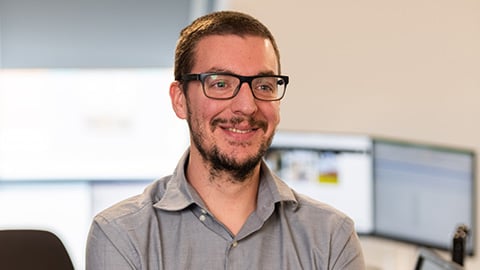
Science set in motion - biomedical trends and the role of data & AI
June 2023
By David Griffin, Principal Consultant, Manufacturing Innovation & Automation at 42T
SLAS 2023 Biomedical Conference highlighted several trends this year. Here's an overview of some of them.
This month, a few of our colleagues attended SLAS Europe 2023 (Society for Laboratory Automation and Screening) the large biomedical conference in Brussels.
There were quite a few interesting talks, from directed evolution of natural enzymes - increasing key function by two orders of magnitude - to a real glimpse of the future of drug discovery where candidates are AI designed rather than discovered, and several years are shaved off the generally accepted lead time.
.jpg?width=760&height=507&name=shutterstock_2321822005%20(1).jpg) The Atomium in Brussels
The Atomium in Brussels
The theme was Science set in Motion
As expected, one of the themes included ever smaller sample sizes, faster and more accurate measurement, and the integration of vendors’ kit into totally automated solutions, all with increased ease of use.
But if there was a underlying take away from the event, it was that anyone entering biopharma these days is primarily entering a career in data science. As one presenter described their huge data set, someone in the audience quipped that he was probably on Amazon's Christmas card list!
Ultimately, the driving philosophy is to do more and do it faster, but in the same sized lab with the same sized team which hopefully means the scientist of the future will spend more time designing automated experiments and interpreting results, and less time getting RSI conducting endless manual experiments!
.jpg?width=757&height=505&name=shutterstock_2152775747%20(1).jpg)
But make no mistake, when brute force testing of hordes of drug candidates is replaced by generative AI design that leapfrogs years of development, it may disrupt the big pharma scientific workforce significantly.
Data driven
Whether it's about medical diagnostics that can detect disease earlier or sensors placed inline in a production process that do the job that used to be done offline with samples taken to a lab, it all comes back to gathering better, faster data. And more of it. Much more. Sometimes game-changingly more.
This inevitably leads on to the other great topic of the day - AI. While the media raves about large language models and catastrophizes about the existential threat of Artificial General Intelligence, domain-specific AI is already delivering real results in a range of applications throughout the industry, finding value in large data sets in a fraction of the time it might have taken in the past. So, if you're not already using AI in your business, you're probably wondering if you should be.
.jpg?width=1178&height=785&name=shutterstock_1091110733%20(1).jpg)
These are exciting times to be in technology innovation, but in some ways the fundamentals remain the same. And that is: find what really needs to be measured, find (or develop) the right sensors with the right range and accuracy, address the gap between the raw sensor numbers and actionable data, build an infrastructure to cost-effectively get the right data to where it can be converted into genuine insights, and create some sort of algorithm to do the processing.
When one really thinks about it, the fundamentals haven't really changed in over 100 years. A lot of current innovation is about doing something that is already be done to some extent, but faster, more accurately, or in a radically more cost-effective way.
How do we do it at 42T?
Our team of usability experts, product designers and engineers apply an iterative approach to developing new healthcare offerings. Prototyping, simulation and testing are key to how we develop highly successful products. By using these tools to address technical, usability and commercial risks along the way, we give our clients confidence in the products they choose to develop.
We consider who will be using the product from the very beginning. Nothing beats testing - but considering various users, their process and how they might think through the use of the device throughout development, will help ensure success.
Our trained facilitators can help you gather insights into how real people use and interact with your product, and draw actionable and meaningful conclusions about how to improve the design.

If you would like to find out more, please contact Craig:
craig.townsend@42T.com | +44 (0)1480 309461 | LinkedIn: Craig
Share this article:
Related Articles

Healthcare & Life Sciences
The future of home healthcare: trends and innovation

Healthcare & Life Sciences
Right to repair: reshaping the medical equipment industry

Healthcare & Life Sciences
The hidden risks with smart injectors - is high-tech sacrificing usability?

What will you ask us today?
We believe in asking the right questions to drive innovation; when we know the right questions, we generate the ideas to answer them.

